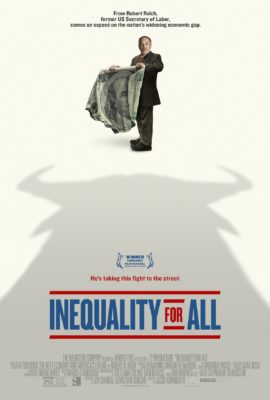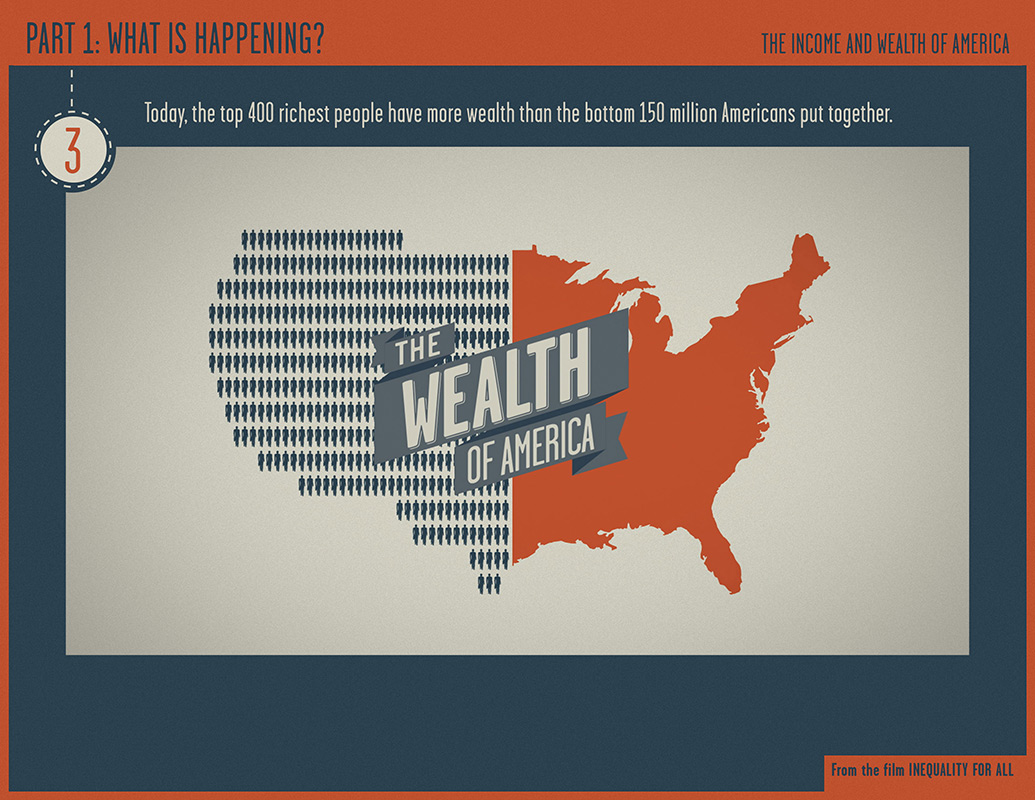Inequality for All is a film based on the work of Robert Reich, a Professor of Public Policy at the University of California at Berkeley and former Secretary of Labor under President Bill Clinton.
This film predates his other film, 2017’s Saving Capitalism by four years, and while there is some overlap in the films, such as Reich’s explanation of the myth of the “free” market, both are worth seeing for all the information in them.
Some scenes in the film are from Reich’s Berkeley “Wealth and Poverty” class. He tells the students that they will explore three questions over the course of the class: what is happening, why, and if it is a problem.
He explains that some inequality is inevitable under capitalism.

Release Year: 2013
Director: Jacob Kornbluth
Running Time: 1 hour, 29 minutes
Watch the trailer
“The question is not inequality, per se. The question is, when does inequality become a problem? How much inequality can we tolerate and still have an economy that’s working for everyone and still have a democracy that is functioning?” Reich asks.
The film examines some of the data about inequality in the United States, including how the levels of inequality in 2001 just before the Great Recession mirrored the previous peak of inequality in 1928, the year before the start of the Great Depression. Also notable is that in 2012, the richest four hundred Americans had more wealth than half the United States population put together.
Reich explains that household and family spending is seventy percent of the United States economy, and the middle class is the heart of that household and family spending. The middle class is what keeps the economy going.
“There’s no way you can sustain the economy over the long term without a strong and vibrant and growing middle class. Can’t be done,” Reich says.
Unfortunately, the middle class is struggling and has been going downhill for years.
The film then jumps to Seattle, spotlighting local entrepreneur and venture capitalist, Nick Hanauer. Hanauer says he generally makes between $10 and $30 million per year between his various businesses. One makes mattresses and pillows.
“The problem with rising inequality is that fewer and fewer people can afford to buy the products we make,” Hanauer says. (The rich, on their own, don’t provide enough of a market for most American businesses.)
He uses himself as an example. Of course the vast majority of the millions he earns each year is not spent. He says he has “no idea what happens with my money” but he is sure “it isn’t creating any kind of social utility other than a return for me.”
After the film shows multiple news clips with people talking about “job creators,” Hanauer tears into this framing.
“Sometimes we think that this is a debate over facts and figures and data. I think if you believe that, you’re fooling yourself,” he begins.
“When somebody calls themselves a ‘job creator,’ they’re not describing the economy or how the economy works, although that’s what it sounds like. What they’re really doing is making a claim on status, privileges, and power.”
It is customers, he says, who are the real job creators.
“We need to replace trickle-down economics with middle-out economics. And indeed, every place you look on Earth where you find prosperity, you find massive investments in the middle class and the poor, because at the end of the day, they are the true job creators,” Hanauer continued. “The most pro-business thing you can do is to help middle class people thrive.”
The film pivots back to Reich, who explains how, starting in the late 1970s, a gap between productivity and wages, which historically rose together, started to grow. Over the last thirty-plus years, productivity has continued to go up, but wages flat-lined. He attributes this to not just the decline of unions, but two other major underlying issues: globalization and technology.
Contrary to popular belief, he says, globalization and tech have not reduced the number of jobs available to Americans.
These forces have, however, reduced the pay of many Americans, even though costs for goods and services have gone up. So people are working harder and harder and harder, and getting nowhere, Reich says.
He then explains how we don’t have to look to other countries for a model of how to make things better, but rather just look to our own past: the United States in the three decades after World War II.
At that time, the virtuous cycle was in full effect.
The cycle goes like this: increasing productivity leads to increased wages; increased wages mean workers buy more; people buying more leads companies to hire more people; more people working means tax revenues increase; the government then uses these increased revenues to invest more in our society; increased public sector investment allows workers to become better educated, which in turn allows for even more productivity, and the economy expands.
Unfortunately, says Reich, these days many people “buy into the lie [that] ‘government is bad, the market is good. Everything that government does works against you and everything the market does helps you.’ ” This myth ignores how markets have been rigged and restructured over the last few decades to further enrich those at the top, at the expense of everyone else.
Reich then explains that when the middle class doesn’t share in economic gains, rather than the uplifting virtuous cycle, you get a downward vicious cycle: wages stagnate, meaning workers buy less, then companies downsize and tax revenues decrease, prompting our elected representatives to cut essential public services, workers are then less educated and unemployment rises, and deficits grow.
Sounds pretty familiar, huh?
As if all of this isn’t bad enough, another thing that must be worried about when inequality reaches such high levels is it’s impact on our democracy.
“With money comes the power to control politics,” says Reich, noting how the amount of money going to lobbyists goes up every year.
“It’s not that people are rich,” says Reich, “It’s that they abuse their wealth by lobbying for bailouts and subsidies and taxes that are going to entrench their wealth. That’s the reason why the rules have changed so dramatically.”
For example, the top marginal tax rates used to be much higher.
Under President Eisenhower, a Republican, they were at the highest rate in history, 91%. It was not until Ronald Reagan’s time that rates went below 70%, and now the top rate is only 37%. Capital gains are taxed at an even lower 15%.
Hanauer, a billionaire, says his effective tax rate is only 11%.
“When you give rich business people tax breaks all in the name of job creation, all that really happens is that the fat cats get fatter. And of course that’s what’s happened over the last thirty years.”
There is no single solution to income inequality, Reich says, but because we make the rules of the economy, that means we have the power to change those rules. To counteract the power that those with all the money have, it will just take more effort. “You’ve got to mobilize. You’ve got to organize,” says Reich.
“You’ve got to energize other people.”
The more we can get people to understand this, especially the rich, the more we can impact the government to fix the rules of the game so that they no longer tilt so decidedly in the favor of those that are already rich.
“Inequality for All” ends with footage of that last day of Reich’s class at Berkeley, where he encourages his students that, no matter how enormous the problem is, individuals can have an impact.
“I choose to be here, in this course, because I believe in you,” he says.
Just as I write, in the hopes that it gives people more information and inspires them to take action.
You can watch “Inequality for All” on Netflix or for a fee on YouTube, iTunes, Vudu, Google Play, or Amazon Prime Video. Reich also maintains an interesting blog, which also has many informative videos if you prefer that to reading his posts, and has an active Facebook presence. I’ve followed him on Facebook for years and find his posts insightful and also grounding in this dystopian age of Trump.
Robert Reich is also the author of numerous books, including “Aftershock”, which is the basis for “Inequality for All.”

